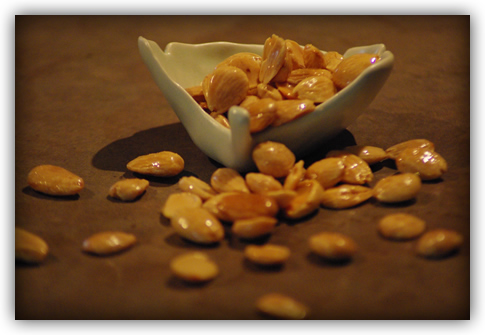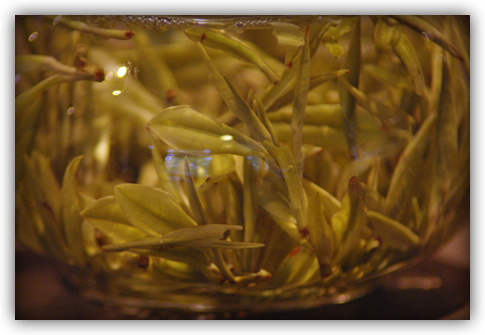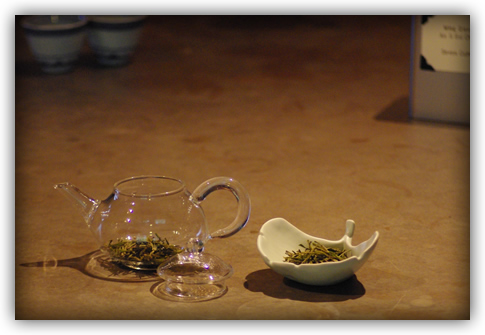I don't want to find that June's passed me by and I've posted nothing at all — especially given the amount of tea-related excitement I've had over the past month and a half — so here's a quick, photo-heavy post to prime the pump for July. (Much thanks to Emily for being so generous with her extremely nice camera.)
In preparing to taste, and to think and write about, this historically fascinating tea, I read a few of those conversations about it already published to the 'net. Steven Knoerr did a really nice tasting notes/controversy round-up post on his blog, The 39 Steeps, in which he excerpts, and links to, this wonderful conversation on T Ching. The conversation involves a number of tea people, but is primarily between the gracious, though misinformed, Mr. James Norwood Pratt (New Tea Lover’s Treasury), and — one of my personal tea heroes — the humble, though learned, Mr. Austin Hodge (Seven Cups). I highly encourage you to read the T Ching comments thread, if nothing else.
My own little batch of Ming Qian An Ji Bai Cha came from Seven Cups, part of my first order from them. And, regardless of its pedigree, this is a very delicious, and quite beautiful, tea.
The first steeping was probably my favorite. It really showed off the nutty qualities in the aroma, and the drier flavor components, which were really nicely complimented by the silky (I would almost say "powdery") mouthfeel.
The second steeping struck me as sort of an awkward, in-between stage, kind of like when you're trying to grow out your hair, but it hasn't gotten properly long yet, just properly messy.
But the third steeping, that was nice. It was sweet, and had a dried apricot element, which reminded me quite strongly of an odd, delicious, white bud bing cha I have secreted away in the cupboard.
At about that point — and this became more and more pronounced in subsequent steepings — a sort of heady, briny, almost metallic quality came into the aroma. It was almost medicinal, but in a very fresh way. Like a newly mown... marsh? It is a very hard scent to pin down; this isn't the first time I've encountered it in a tea, but I'm still not sure what it reminds me of.
In any case, I'm glad I got myself a few grams of this historical enigma; seeing hints of the future in my tea leaves might be supernatural, but hearing echos of the past is divine.
TeaSpring.com has audio notes on pronunciation here.
In preparing to taste, and to think and write about, this historically fascinating tea, I read a few of those conversations about it already published to the 'net. Steven Knoerr did a really nice tasting notes/controversy round-up post on his blog, The 39 Steeps, in which he excerpts, and links to, this wonderful conversation on T Ching. The conversation involves a number of tea people, but is primarily between the gracious, though misinformed, Mr. James Norwood Pratt (New Tea Lover’s Treasury), and — one of my personal tea heroes — the humble, though learned, Mr. Austin Hodge (Seven Cups). I highly encourage you to read the T Ching comments thread, if nothing else.
My own little batch of Ming Qian An Ji Bai Cha came from Seven Cups, part of my first order from them. And, regardless of its pedigree, this is a very delicious, and quite beautiful, tea.
The first steeping was probably my favorite. It really showed off the nutty qualities in the aroma, and the drier flavor components, which were really nicely complimented by the silky (I would almost say "powdery") mouthfeel.
The second steeping struck me as sort of an awkward, in-between stage, kind of like when you're trying to grow out your hair, but it hasn't gotten properly long yet, just properly messy.
But the third steeping, that was nice. It was sweet, and had a dried apricot element, which reminded me quite strongly of an odd, delicious, white bud bing cha I have secreted away in the cupboard.
At about that point — and this became more and more pronounced in subsequent steepings — a sort of heady, briny, almost metallic quality came into the aroma. It was almost medicinal, but in a very fresh way. Like a newly mown... marsh? It is a very hard scent to pin down; this isn't the first time I've encountered it in a tea, but I'm still not sure what it reminds me of.
In any case, I'm glad I got myself a few grams of this historical enigma; seeing hints of the future in my tea leaves might be supernatural, but hearing echos of the past is divine.
TeaSpring.com has audio notes on pronunciation here.






